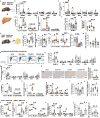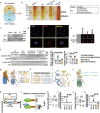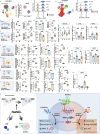Sodium nitrate protects against metabolic syndrome by sialin-mediated macrophage rebalance
- PMID: 41034188
- PMCID: PMC12488962
- DOI: 10.1038/s41392-025-02418-1
Sodium nitrate protects against metabolic syndrome by sialin-mediated macrophage rebalance
Abstract
Metabolic syndrome, characterized by metabolic dysfunction-associated steatotic liver disease (MASLD) and type 2 diabetes mellitus (T2DM), poses a significant threat to patients' health worldwide; however, efficient treatment is currently unavailable. Here, we show that oral administration of sodium nitrate (NaNO3) greatly attenuates the development and advancement of MASLD-like and T2DM-like phenotypes in mice induced by choline-deficient high-fat, western, or methionine/choline-deficient diet. NaNO3 attenuates metabolic turbulence by rebalancing CD206+/CD11C+ polarization (anti-inflammatory/pro-inflammatory) and the function of bone marrow-derived macrophages (MoMFs). Using metabolic disorder animal models and bone marrow-reconstituted mice with mutated gene function in Slc17a5, which encodes sialin, we demonstrate that NaNO3 protects against metabolic disorders through the actions of sialin in MoMFs. NaNO3 can directly regulate MoMFs polarization and function in vitro and in mice, in which nitric oxide production from oral and enteral symbiotic bacteria is essentially abolished. At the molecular level, sialin, via the inhibition of the key transcription factor Rel, inhibits cathepsin L (CtsL) expression and thereby activates the Nrf2 pathway to modulate macrophage homeostasis and ameliorate metabolic abnormalities. Interestingly, the sialin-CtsL-Nrf2 pathway is downregulated in human macrophages from metabolic dysfunction-associated steatohepatitis (MASH) patients. Overall, we demonstrate the prophylactic and therapeutic effects of NaNO3 on metabolic syndrome and reveal a new macrophage rebalancing strategy involving NaNO3 through a novel sialin pathway. Our research indicates that NaNO3 may be a pharmaceutical agent for managing and alleviating metabolic turbulence in humans.
© 2025. The Author(s).
Conflict of interest statement
Competing interests: The authors declare no competing interests.
Figures








References
-
- Younossi, Z. et al. Global burden of NAFLD and NASH: trends, predictions, risk factors and prevention. Nat. Rev. Gastroenterol. Hepatol.15, 11–20 (2018). - PubMed
-
- Powell, E. E., Wong, V. W. & Rinella, M. Non-alcoholic fatty liver disease. Lancet397, 2212–2224 (2021). - PubMed
-
- Rinella, M. E. et al. A multisociety Delphi consensus statement on new fatty liver disease nomenclature. J. Hepatol.79, 1542–1556 (2023). - PubMed
-
- Krenkel, O. & Tacke, F. Liver macrophages in tissue homeostasis and disease. Nat. Rev. Immunol.17, 306–321 (2017). - PubMed
MeSH terms
Substances
Grants and funding
LinkOut - more resources
Full Text Sources
Medical
Research Materials

